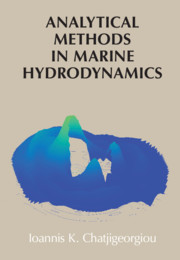Book contents
- Analytical Methods in Marine Hydrodynamics
- Dedication
- Analytical Methods in Marine Hydrodynamics
- Copyright page
- Contents
- Foreword
- Preface
- Note on Symbols and Notations
- 1 Description of the Flow
- 2 Linear Hydrodynamics of Circular Cylinders
- 3 Higher-Order Phenomena for Circular Cylinders
- 4 Hydrodynamics of Elliptical Cylinders
- 5 Hydrodynamics of Spheres and Spheroids
- 6 Hydrodynamics of Ellipsoids
- Book part
- References
- Index
6 - Hydrodynamics of Ellipsoids
Published online by Cambridge University Press: 27 June 2018
- Analytical Methods in Marine Hydrodynamics
- Dedication
- Analytical Methods in Marine Hydrodynamics
- Copyright page
- Contents
- Foreword
- Preface
- Note on Symbols and Notations
- 1 Description of the Flow
- 2 Linear Hydrodynamics of Circular Cylinders
- 3 Higher-Order Phenomena for Circular Cylinders
- 4 Hydrodynamics of Elliptical Cylinders
- 5 Hydrodynamics of Spheres and Spheroids
- 6 Hydrodynamics of Ellipsoids
- Book part
- References
- Index
Summary
Georg Weinblum (1897–1974) used to say ‘The ellipsoid is God’s gift to naval architects!’ (quoted by J. N. Newman, 1972). Apparently, Georg Weinblum wanted to stress the equivalence of the geometry of an ellipsoid with a ship’s hull. It should be admitted, however, that this might be true for some old-fashioned ships, but not for a modern ship’s structure. Nevertheless, none could decline that the geometry of an ellipsoid can approximate the hull of a ship, at least as far as slender hulls are concerned. Here, there is an additional difficulty that must be mentioned. A ship’s hull, and in particular what we are concerned within the hydrodynamical context, namely the part below the free surface, is a half-ellipsoid. In terms of analytical formulations one may easily realize the challenges associated with relevant approximations given that there are no credible tools for investigating even a fully immersed ellipsoid.
Analytical approaches rely on harmonics, and in ellipsoidal geometry those harmonics are constructed by products of Lamé functions. The problem with Lamé functions is that they are not familiar to researchers. The available literature is limited, and their properties are still concealed. For eighty years one relied only on the short information provided by Hobson (1931), who dedicated only one chapter (IX) and forty-three pages to the theory of ellipsoidal harmonics. This gap was somehow filled in by the book by Dassios (2012), while intermediate efforts were sporadic and incomplete. It wouldn’t be an overstatement if one claimed that Lamé functions were forgotten for a long time. An additional challenge associated with Lamé functions is their calculation. Their expansions are of polynomial form depending on expansion coefficients given as functions of characteristic values. So far, no software generally acceptable as credible has been delivered and the efforts in the area are customized and ad hoc. Given that, in the quest for analytical approaches it is very important to use a sufficient number of harmonics until convergence, and efficient computations of harmonics for, hypothetically, unlimited degrees and orders, constitute an unavoidable necessity.
In the context of hydrodynamics in ellipsoidal geometry, even fewer efforts have been undertaken. The majority of them are thanks to world leaders in hydrodynamicists, such as the late Louis Landweber (1912–1998) and Touvia Miloh (b. 1943). The solutions of three-dimensional boundary value problems of closed geometries such as ellipsoids rely, as highlighted in Chapter 5, on the method of multipoles. To this end, an appropriate theorem in ellipsoidal geometry, analogous to the “sphere” theorem of Hobson (1931), or the “prolate spheroid” theorem of Havelock (1952) should be used. Such a theorem was developed and reported by Miloh (1974), which however, in terms of implementation didn’t attract much attention.
In this chapter, an effort has been made to collect all available information and contemporary analysis tools associated with boundary value problems involving ellipsoids. A significant part of the chapter is dedicated to Lamé functions and their properties, including the method for their numerical calculation. Several hydrodynamic boundary value problems are formulated, including water-wave diffraction, wave resistance, motion of an ellipsoid close to a wall or in channel, the ship crossing problem, etc. The authorship of this chapter wouldn’t be feasible without the assistance of the two world leading experts in ellipsoidal harmonics, Professors George Dassios and Touvia Miloh.
Information
- Type
- Chapter
- Information
- Analytical Methods in Marine Hydrodynamics , pp. 334 - 396Publisher: Cambridge University PressPrint publication year: 2018
